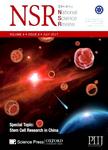Intelligent gold nanocluster for effective treatment of malignant tumor via tumor-specific photothermal–chemodynamic therapy with AIE guidance
作者机构:School of Energy and Power EngineeringXi'an Jiaotong University Department of Chemical EngineeringShaanxi Key Laboratory of Energy Chemical Process IntensificationInstitute of Polymer Science in Chemical Engineering School of Chemical Engineering and Technology Xi'an Jiaotong University School of Pharmacy Health Science Center Xi'an Jiaotong University
出 版 物:《National Science Review》 (国家科学评论(英文版))
年 卷 期:2024年第11卷第5期
页 面:326-342页
核心收录:
学科分类:1002[医学-临床医学] 100214[医学-肿瘤学] 10[医学]
基 金:supported by the National High Level Talents Special Support Plan the National Natural Science Foundation of China (82272141) the ‘Young Talent Support Plan’ of Xi’an Jiaotong University the Shaanxi Innovative Research Team of Science and Technology (S2023-ZC-TD-0152) the Natural Science Foundation of Shaanxi Province (2022JZ-48) the National Key Research and Development Program of China(2023YFC2509104)
主 题:AIE-guided precise tumor treatment copper-dependent photothermal therapy copper-triggered chemodynamic therapy primary tumor elimination copper-plunder-induced metastasis inhibition
摘 要:Precise and efficient therapy of malignant tumors is always a challenge. Herein, gold nanoclusters co-modified by aggregation-induced-emission(AIE) molecules, copper ion chelator(acylthiourea) and tumor-targeting agent(folic acid) were fabricated to perform AIE-guided and tumor-specific synergistic therapy with great spatio-temporal controllability for the targeted elimination and metastasis inhibition of malignant tumors. During therapy, the functional gold nanoclusters(Au NTF) would rapidly accumulate in the tumor tissue due to the enhanced permeability and retention effect as well as folic acid-mediated tumor targeting, which was followed by endocytosis by tumor cells. After that, the overexpressed copper ions in the tumor cells would trigger the aggregation of these intracellular Au NTF via a chelation process that not only generated the photothermal agent in situ to perform the tumor-specific photothermal therapy damaging the primary tumor, but also led to the copper deficiency of tumor cells to inhibit its ***, the copper ions were reduced to cuprous ions along with the chelation, which further catalysed the excess H2O2in the tumor cells to produce cytotoxic reactive oxygen species, resulting in additional chemodynamic therapy for enhanced antitumor efficiency. The aggregation of Au NTF also activated the AIE molecules to present fluorescence, which not only imaged the therapeutic area for real-time monitoring of this tumor-specific synergistic therapy, but also allowed us to perform near-infrared radiation at the correct time point and location to achieve optimal photothermal therapy. Both in vitro and in vivo results revealed the strong tumor elimination, effective metastasis inhibition and high survival rate of tumor-bearing mice after treatment using the Au NTF nanoclusters, indicating that this AIE-guided and tumor-specific synergistic strategy could offer a promising approach for tumor therapy.



